|
Battle Cry!
by Bob Brooke
The Romans built an
empire on the feet of their soldiers. Equipping the Roman army was
no small feat. For efficiency, the Romans produced personal military
equipment in small numbers to standard patterns and used it in an
established way. They called these standard patterns and uses res
militaris or disciplina. This practice led to military
excellence and victory since the equipment gave the Romans a
distinct advantage over their barbarians.
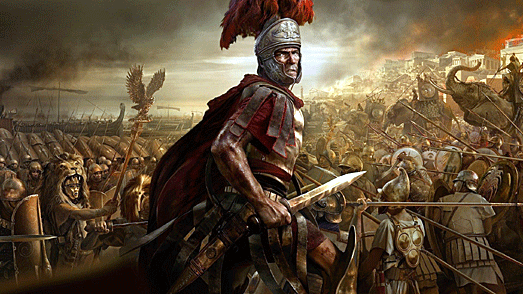
Roman Body Armor
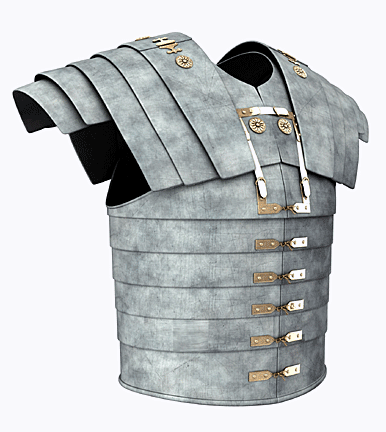 The
amount and effectiveness of body protection varied according to rank.
Not all troops wore torso armor. Light infantry, especially in the early
republic, wore little or no armor. This was both to allow swifter
movement for light troops and also as a matter of cost. The
amount and effectiveness of body protection varied according to rank.
Not all troops wore torso armor. Light infantry, especially in the early
republic, wore little or no armor. This was both to allow swifter
movement for light troops and also as a matter of cost.
Legionary soldiers of the 1st and 2nd centuries used a variety of armor
types. Some wore lorica amata or mail shirts, while others wore
lorica segmentata, or scale armor. The latter was a complex piece of
armor which often provided superior protection to other types of Roman
armor. Forensic scientists have discovered through testing of modern
replicas that this kind of armor was impenetrable to most direct hits
and missile strikes.
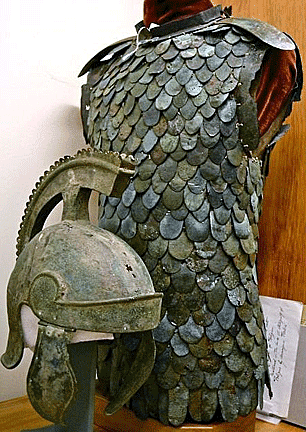 Lorica
segmentata was a type of body armor primarily used in the early
Roman Empire. It consisted of broad iron strips, known as girth hoops,
fastened to internal leather straps. Arranged horizontally on the body
and overlapping downwards, they surrounded the torso in two halves,
being fastened at the front and back by means of brass hooks joined by
leather laces. Shoulder guard strips and breast- and backplates
protected the shoulders and upper body. The form of the armor allowed it
to be stored very compactly, since it was possible to separate it into
four sections. This type of armor was quite common until the 2nd century
CE. Lorica
segmentata was a type of body armor primarily used in the early
Roman Empire. It consisted of broad iron strips, known as girth hoops,
fastened to internal leather straps. Arranged horizontally on the body
and overlapping downwards, they surrounded the torso in two halves,
being fastened at the front and back by means of brass hooks joined by
leather laces. Shoulder guard strips and breast- and backplates
protected the shoulders and upper body. The form of the armor allowed it
to be stored very compactly, since it was possible to separate it into
four sections. This type of armor was quite common until the 2nd century
CE.
Some historians believe that only legionaries—heavy infantry of the
Roman legions—and praetorians wore lorica segmentata. Auxiliary
forces would more commonly wear the lorica hamata. Others believe
both legionaries and auxiliary soldiers used the segmentata
armor. Archaeological findings seem to support this. The lorica
segmentata offered greater protection than the lorica hamata
for about half of the weight but was also more difficult to produce and
repair.
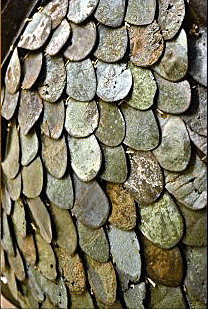 Lorica
squamata was a type of scale armor used during the Roman Republic
and later. Made from small metal scales sewn to a fabric backing, it
typically appears on depictions of standard bearers, musicians,
centurions, cavalry troops, and even auxiliary infantry, but could be
worn by regular legionaries as well. A shirt of scale armor, shaped in
the same way as a lorica hamata, was mid-thigh length with the
shoulder doublings or cape. Lorica
squamata was a type of scale armor used during the Roman Republic
and later. Made from small metal scales sewn to a fabric backing, it
typically appears on depictions of standard bearers, musicians,
centurions, cavalry troops, and even auxiliary infantry, but could be
worn by regular legionaries as well. A shirt of scale armor, shaped in
the same way as a lorica hamata, was mid-thigh length with the
shoulder doublings or cape.
The individual squamae, or scales, were either iron or bronze.
The metal was generally not very thick, commonly from 0.02 to 0.032
inches. Many had rounded bottoms, while others were pointed or had flat
bottoms with the corners clipped off at an angle. The scales could be
flat, slightly domed, or have a raised midrib or edge. All the scales in
a shirt were generally the same size; however, scales from different
shirts varied widely.
Wired together in horizontal rows, the scales were then laced or sewn to
the backing, giving each scale from four to twelve holes, two or more at
each side for wiring to the next in the row, one or two at the top for
fastening to the backing, and sometimes one or two at the bottom to
secure the scales to the backing or to each other.
Greaves, sheet metal protecting the legs, were widely used in the late
republic, and by some troops in the imperial army.
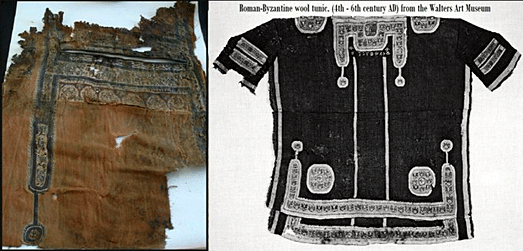
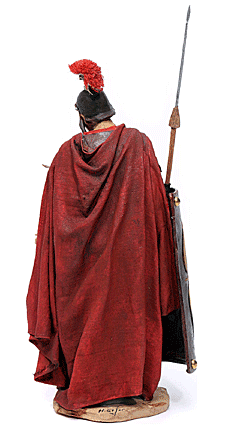 Roman
soldiers wore a woolen tunic under their armor. They originally
consisted simply of a piece of rectangular cloth sewn to an identical
piece, with holes for the arms and head left unsewn. Later, it became
fashionable for tunics to be produced with sleeves, and worn with woolen
trousers called braccae. Roman
soldiers wore a woolen tunic under their armor. They originally
consisted simply of a piece of rectangular cloth sewn to an identical
piece, with holes for the arms and head left unsewn. Later, it became
fashionable for tunics to be produced with sleeves, and worn with woolen
trousers called braccae.
Legionaries also wore a scarf to protect their necks from chafing caused
by constant contact with their armor. In addition, they wore a sword
belt called a balteus.
Roman soldiers wore two types of cloaks—the sagum and the
paenula—both fastened with a fibula. Made from wool, they offered
insulation and kept the soldier dry in wet weather. Those assigned to
colder climates wore a paenula, a hooded cloak. Since every
common soldier slept in the open, it was important that he have a warm
full-length wrap, but necessary that he carry it with him each day
regardless of his activities. Thus cloaks were more than body length,
double-folded so that they did not fall beneath the knees when worn.
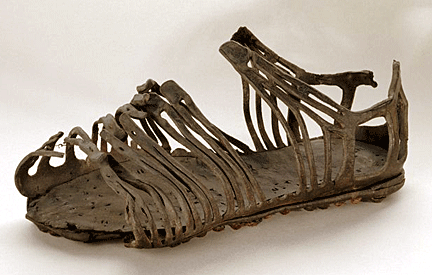 Legionaries
and auxiliaries wore boots called caligae, made from leather and
laced up the center and onto the top of the ankle. Bootmakers hammered
hobnails, similar to modern golf cleats, into the soled for added
strength. Legionaries
and auxiliaries wore boots called caligae, made from leather and
laced up the center and onto the top of the ankle. Bootmakers hammered
hobnails, similar to modern golf cleats, into the soled for added
strength.
To protect the upper legs, soldiers wore pteruges, a skirt of
leather or fabric strips worn around the waist. Pteruges were
often fitted with small metal studs and plates to provide additional
protection.
Additional Protective Gear
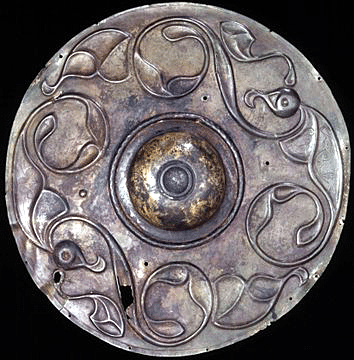 Each
soldier in the lowest class division of the army—the velites—carried
a three-foot circular shield called a parma. It was smaller than
most shields but was strongly made and provided effective protection,
due to its iron frame. Each shield also had a handle and a shield boss,
called an umbo. Each
soldier in the lowest class division of the army—the velites—carried
a three-foot circular shield called a parma. It was smaller than
most shields but was strongly made and provided effective protection,
due to its iron frame. Each shield also had a handle and a shield boss,
called an umbo.
Roman helmets, galea or cassis, varied greatly in form. One of
the earliest types was the Montefortino helmet used by the Roman
Republic armies up to the 1st century BCE. The Romans soon replaced it
with the Coolus helmet, which raised the neck peak to eye level and set
a sturdy frontal peak to the brow of the helmet.
Roman Weapons
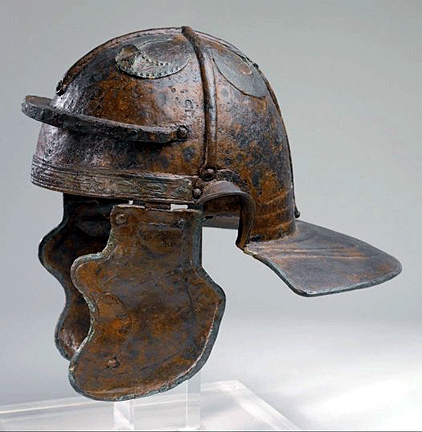 Originally,
the Romans used weapons based on Greek and Etruscan models. But as they
encountered new adversaries, they added new weapons to counter them.
Once the Romans adopted a new weapon, it became standard. Originally,
the Romans used weapons based on Greek and Etruscan models. But as they
encountered new adversaries, they added new weapons to counter them.
Once the Romans adopted a new weapon, it became standard.
Roman soldiers used a dagger called a pugio as a sidearm. Generally, it
had a large, leaf-shaped blade 18 to 28 cm long and 5 cm or more in
width. A raised midrib ran the length of each side, either simply
standing out from the face or defined by grooves on either side. Later,
the Romans made the blade a little thinner and the handle out of metal.
The tang was wide and flat initially, with the grip riveted through it,
as well as through the shoulders of the blade.
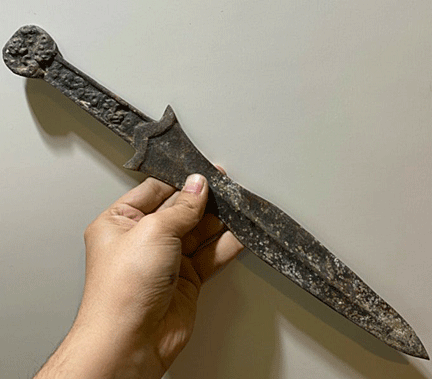 Gladius
is the general Latin word for "sword," thus the word gladiator for
someone who carries one. In the Roman Republic, the term gladius
Hispaniensis or Spanish sword, referred to the 24-inch-long short
sword, used by Roman legionaries from the 3rd century BCE. The two
primary types of swords were the Mainz gladius and the Pompeii
gladius. The legionaries wore their gladii on their right
hips. Gladius
is the general Latin word for "sword," thus the word gladiator for
someone who carries one. In the Roman Republic, the term gladius
Hispaniensis or Spanish sword, referred to the 24-inch-long short
sword, used by Roman legionaries from the 3rd century BCE. The two
primary types of swords were the Mainz gladius and the Pompeii
gladius. The legionaries wore their gladii on their right
hips.
A spatha referred to any sword, but most often one of the longer
ones used during the middle to late Roman Empire. In the 1st century,
Roman cavalry began using these longer swords, and in the late 2nd or
early 3rd century, Roman infantry also switched to longer swords.
 Early
Roman legionaries carried a thrusting spear called a hasta, which
gave those soldiers their name---hastati. A hasta was
about six feet long and had a six-foot shaft made from ash topped by an
iron tip—earlier hastae carried one with a bronze tip. Early
Roman legionaries carried a thrusting spear called a hasta, which
gave those soldiers their name---hastati. A hasta was
about six feet long and had a six-foot shaft made from ash topped by an
iron tip—earlier hastae carried one with a bronze tip.
Although Romans often used the word pila to refer to all
javelins, the term pilum also referred specifically to the heavy
Roman throwing javelin of the legions. This 6½-foot-long spear had a
wooden shaft from which projected an iron shank about 1/4 inch in
diameter and 23½ inches long with a pyramidal tip. A pilum
usually weighed between 4½ and 9 pounds. However, lighter, shorter
javelins existed, such as those used by the velites and the early
legionaries.
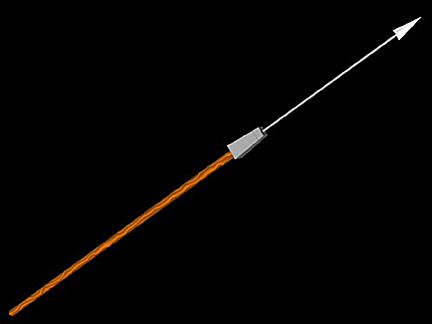 The
Romans designed pila to penetrate both shield and armor, wounding the
wearer; but if they simply stuck in a shield, the enemy could not easily
remove it. Some believed that the iron shank would bend upon impact,
weighing down the enemy's shield and also preventing the pilum
from being immediately re-used by the enemy. They reduced the
effectiveness of enemy shields by simply getting stuck due to the shape
of its larger head and thin shank. Typically, the first four ranks of
the formation should use their pila like spearmen, while the rest
used them like javelins. The
Romans designed pila to penetrate both shield and armor, wounding the
wearer; but if they simply stuck in a shield, the enemy could not easily
remove it. Some believed that the iron shank would bend upon impact,
weighing down the enemy's shield and also preventing the pilum
from being immediately re-used by the enemy. They reduced the
effectiveness of enemy shields by simply getting stuck due to the shape
of its larger head and thin shank. Typically, the first four ranks of
the formation should use their pila like spearmen, while the rest
used them like javelins.
A composite bow called a arcus shot an arrow called a
sagittarius made of horn, wood, and sinew held together with hide
glue.
Late infantrymen often carried half-dozen lead-weighted throwing-darts
called plumbatae, from plumbum, meaning "lead." These had an
effective range of about 30 meters, well beyond that of a javelin.
Soldiers typically carried these darts clipped to the back of their
shields.
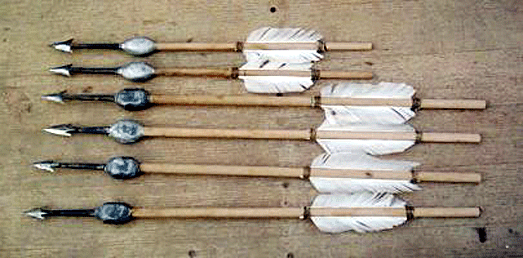
Although not technically a weapon, the spade was an essential part of
each soldier’s kit. Roman historians described how Roman legionaries
would dig a ditch and rampart around their camps every night when on the
march. Some also used them as improvised weapons.
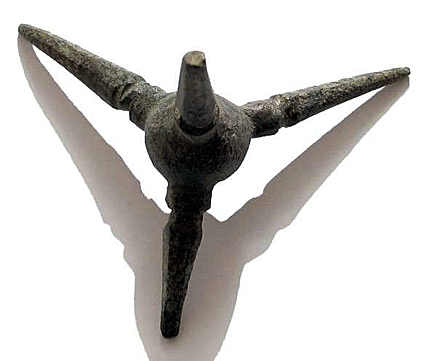 Soldiers
use a falx, a curved blade that was sharp on the inside edge such
as a sickle or a scythe, to clear overgrowth. Soldiers
use a falx, a curved blade that was sharp on the inside edge such
as a sickle or a scythe, to clear overgrowth.
One of the most unusual weapons used by Roman soldiers was the
tribulus or caltrop, a weapon made up of four sharp nails or spines
arranged so that one of them always pointed upward from a stable base.
Caltrops served to slow down the advance of horses, war elephants, and
human troops. Roman historians noted that it was said to be particularly
effective against the soft feet of camels.
<
Back to More Antique Spotlights
Next
Article >
|
